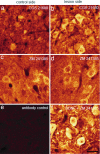Adenosine receptor A2A-R contributes to motoneuron survival by transactivating the tyrosine kinase receptor TrkB
- PMID: 17940030
- PMCID: PMC2040418
- DOI: 10.1073/pnas.0705267104
Adenosine receptor A2A-R contributes to motoneuron survival by transactivating the tyrosine kinase receptor TrkB
Abstract
Neurotrophins are potent survival factors for developing and injured neurons. However, they are not being used to treat neurodegenerative diseases because of difficulties in administration and numerous side effects that have been encountered in previous clinical trials. Their biological activities use Trk (tropomyosin-related kinase) transmembrane tyrosine kinases. Therefore, one alternative approach is to use transactivation pathways such as adenosine 2A receptor agonists, which can activate Trk receptor signaling independent of neurotrophin binding. However, the relevance in vivo and applicability of these transactivation events during neurodegenerative and injury conditions have never been extensively studied. Here we demonstrate that motoneuron survival after facial nerve lesioning is significantly enhanced by transactivation of Trk receptor tyrosine kinases by adenosine agonists. Moreover, survival of motoneurons directly required the activation of the BDNF receptor TrkB and an increase in Akt (AKT8 virus oncogene cellular homolog) activity. The ability of small molecules to activate a trophic response by using Trk signaling provides a unique mechanism to promote survival signals in motoneurons and suggests new strategies for using transactivation in neurodegenerative diseases.
Conflict of interest statement
The authors declare no conflict of interest.
Figures




Similar articles
-
Trk and cAMP-dependent survival activity of adenosine A(2A) agonist CGS21680 on rat motoneurons in culture.Neurosci Lett. 2012 Jul 26;522(1):21-4. doi: 10.1016/j.neulet.2012.06.003. Epub 2012 Jun 9. Neurosci Lett. 2012. PMID: 22691937
-
Spinal adenosine A2a receptor activation elicits long-lasting phrenic motor facilitation.J Neurosci. 2008 Feb 27;28(9):2033-42. doi: 10.1523/JNEUROSCI.3570-07.2008. J Neurosci. 2008. PMID: 18305238 Free PMC article.
-
Deletion of the BDNF truncated receptor TrkB.T1 delays disease onset in a mouse model of amyotrophic lateral sclerosis.PLoS One. 2012;7(6):e39946. doi: 10.1371/journal.pone.0039946. Epub 2012 Jun 27. PLoS One. 2012. PMID: 22761934 Free PMC article.
-
Distinctive features of Trk neurotrophin receptor transactivation by G protein-coupled receptors.Cytokine Growth Factor Rev. 2002 Feb;13(1):11-7. doi: 10.1016/s1359-6101(01)00024-7. Cytokine Growth Factor Rev. 2002. PMID: 11750876 Review.
-
Promoting neurotrophic effects by GPCR ligands.Novartis Found Symp. 2006;276:181-9; discussion 189-92, 233-7, 275-81. Novartis Found Symp. 2006. PMID: 16805430 Review.
Cited by
-
Role for engagement of β-arrestin2 by the transactivated EGFR in agonist-specific regulation of δ receptor activation of ERK1/2.Br J Pharmacol. 2015 Oct;172(20):4847-63. doi: 10.1111/bph.13254. Epub 2015 Sep 23. Br J Pharmacol. 2015. PMID: 26211551 Free PMC article.
-
TrkB Truncated Isoform Receptors as Transducers and Determinants of BDNF Functions.Front Neurosci. 2022 Mar 7;16:847572. doi: 10.3389/fnins.2022.847572. eCollection 2022. Front Neurosci. 2022. PMID: 35321093 Free PMC article.
-
Modulation of neurotrophic signaling pathways by polyphenols.Drug Des Devel Ther. 2015 Dec 21;10:23-42. doi: 10.2147/DDDT.S96936. eCollection 2016. Drug Des Devel Ther. 2015. PMID: 26730179 Free PMC article. Review.
-
Interplay of BDNF and GDNF in the Mature Spinal Somatosensory System and Its Potential Therapeutic Relevance.Curr Neuropharmacol. 2021;19(8):1225-1245. doi: 10.2174/1570159X18666201116143422. Curr Neuropharmacol. 2021. PMID: 33200712 Free PMC article. Review.
-
Phrenic long-term facilitation after acute intermittent hypoxia requires spinal ERK activation but not TrkB synthesis.J Appl Physiol (1985). 2012 Oct 15;113(8):1184-93. doi: 10.1152/japplphysiol.00098.2012. Epub 2012 Sep 6. J Appl Physiol (1985). 2012. PMID: 22961271 Free PMC article.
References
Publication types
MeSH terms
Substances
LinkOut - more resources
Full Text Sources
Other Literature Sources

